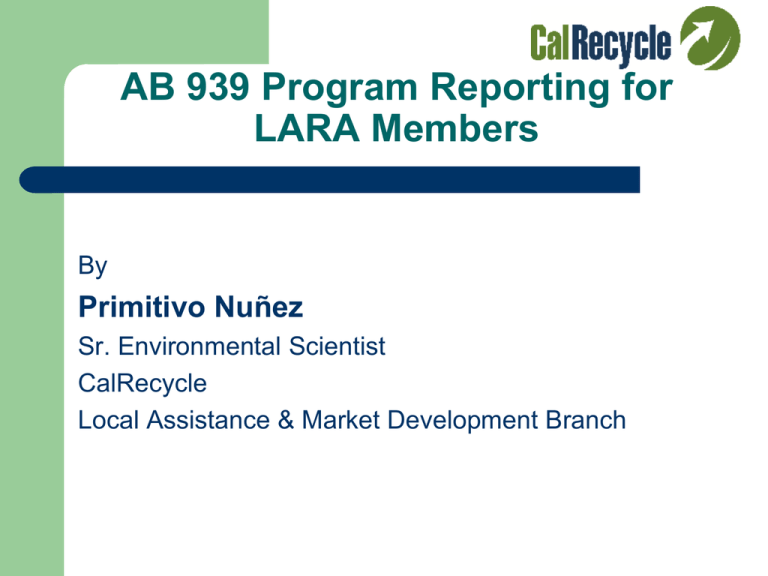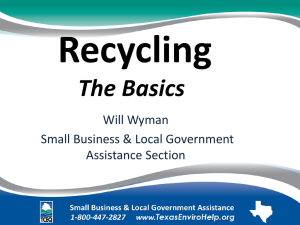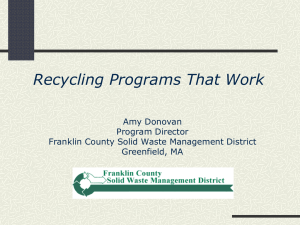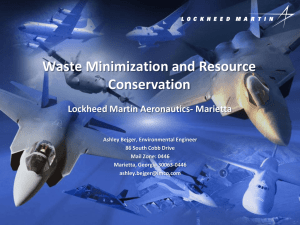AB939 Program Reporting for LARA members
advertisement

AB 939 Program Reporting for LARA Members By Primitivo Nuñez Sr. Environmental Scientist CalRecycle Local Assistance & Market Development Branch Reporting of Local Programs AB 939 Integrated Waste Management Act (1989) – Set diversion goals, planning/implementation process, compliance mechanism, oversight Local diversion program reporting requirements prescribed in Title 14, California Code of Regulations, Sections 18790 and 18794.3 Must report all programs described in the jurisdictions Source Reduction and Recycling Element (SRRE) and Household Hazardous Waste Element (HHWE). Diversion Program Reporting Local governments required to report every year CalRecycle required to track, monitor and review program implementation Provides local coordinators opportunity to annually review program activities Streamlined process to update Source Reduction and Recycling Element (SRRE) Reported Information Program descriptions Start dates and program status Changes in programs Targeted sectors (i.e. residential, commercial, Industrial, government, etc.) Targeted materials (i.e. organics, special wastes, construction and demolition, etc.) Diversion Program Notes • Electronic Annual Report Database to hold local program information • Establishes program code consistency • Standardized interface for locals to report on and CalRecycle staff to review program efforts • Web-based reports for staff and public Diversion Program Classifications: 9 High-level groupings (series) – – – – – – – – – Source Reduction (1000 Series) Recycling (2000 Series) Composting (3000 Series) Special Waste Materials (4000 Series) Public Education (5000 Series) Policy Incentives (6000 Series) Facility Recovery (7000 Series) Transformation (8000 Series) Household Hazardous Waste (9000 Series) Program Perspectives Examples of local programs and how they fit into Diversion Program categories. Source Reduction (1000 Series) Xeriscaping - landscaping with slow-growing, drought tolerant plants to conserve water and reduce yard trimmings Grasscycling - natural recycling of grass by leaving clippings on the lawn when mowing Procurement – EPP/recycled content products Source Reduction (1000 Series) Business, School or Government Source Reduction Simple things CalRecycle and locals promote to businesses. Source Reduction (1000 Series) Materials Exchange Jurisdictions can exchange waste materials as a form of diversion. “Mini-Max’s” are listed below: Recycling (2000 Series) Residential Curbside Programs Programs vary between Commingled, Source Separated, or Mixed Waste Recycling (2000 Series) Residential Buy-Back/Drop-Off Centers Most cities have buy back programs that relate to CalRecycle Division of Recycling’s CRV program. Recycling (2000 Series) Commercial Onsite Pick Up Mandatory Commercial Recycling o o o o Total number of businesses subject to law Total number of multi-family complexes subject to law Total number of each not recycling Actions taken by jurisdiction to ensure they are aware of the requirements. Composting (3000 Series) Residential Curbside Greenwaste Collection • Jurisdictions with greenwaste collection typically transport it to a composting facility or to a landfill for use as ADC (Alternative Daily Cover) • Curbside pickup provided weekly or biweekly placed in cans, bags, rolling carts or in the street. Composting (3000 Series) Food Waste Composting Residential and Commercial Pick-Up (Can be mixed with greenwaste) Example: • Some cities collect and compost food scraps, soiled paper and yard trimmings from residents and some commercial accounts (e.g., restaurants). • Special Waste Materials (4000 Series) Ash Disaster Debris Sludge Tires White Goods Public Education (5000 Series) Electronic Public Service Announcements Radio Television Web Sites Media Campaigns Twitter/Facebook Public Education (5000 Series) Print Brochures Newsletter Articles Fliers Fact Sheets Recycling guide New resident package Public Education (5000 Series) Outreach Technical Assistance Presentations Awards Seminars Workshops Exhibits Merced Composting Facility Tour and Outreach Event Public Education (5000 Series) Schools Curriculum Development Grants to Schools Education Programs Example: Los Angeles County Environmental Defenders Assembly Program – Schools can request a free assembly on recycling. Policy Incentives (6000 Series) Product and Landfill Bans Examples: Green Waste Ash C&D Debris White Goods Policy Incentive (6000 Series) Ordinances Local ordinances can create policy incentives and lead to successful programs. CalRecycle developed a model construction and demolition (C&D) diversion ordinance CalGreen updates The City of Torrance requires all demolition projects and construction or remodeling projects valued at $100,000 or more to recycle or reuse at least 50% of the materials that leave the project site. Policy Incentives (6000 Series) Economic Incentives Local governments can influence the economics of the marketplace by the way they structure their: Garbage collection rates (pay as you throw) Franchise fees AB 939 fees Permit fees Facility taxes Facility Recovery (7000 Series) Material Recovery Facilities (MRF’s) Manual MRF’s Mechanized MRF’s Dirty MRFs C&D MRFs Facility Recovery (7000 Series) Landfills Although landfills are the disposal location for many materials, diversion programs often occur Beneficial Use of Cover and Landfill Construction Materials Construction & Demolition Processing Recycling and Salvage Operations Alternative Daily Cover Composting Facility Recovery (7000 Series) Organic Processing Facilities Aerobic, Windrow Aerobic, Static Pile Anaerobic In-Vessel Chipping/Mulching Vermicomposting Norcal’s Jepson Prairie Organics Composting Facility in Dixon, CA Transformation (8000 Series) Waste-to-Energy Jurisdictions can get disposal deductions for using waste-to-energy facilities. Southeast Resource Recovery Facility (SERRF) is a Waste-to-Energy facility in Long Beach that processes an average of 1,290 tons of municipal solid waste each day. SERRF produces enough electricity to furnish more than 35,000 homes with electrical power. Transformation (8000 Series) Biomass Biomass-to-Energy Facilities throughout the State Use significant amounts of wood and green waste Household Hazardous Waste (9000 Series) Permanent Facility Some jurisdictions have access to permanent collection facilities for drop-off of HHW (S.A.F.E. Centers in City of L.A.) Most jurisdictions have more than one permanent collection facility for Used Oil = Certified Collection Centers (CCC) Household Hazardous Waste (9000 Series) Mobile Collection Facilities or Events Many jurisdictions have access to mobile collection facilities or special events which allow drop-off of HHW. The County of L.A. hosts regional HHW Collection events throughout the year throughout the County. Household Hazardous Waste (9000 Series) Education Programs Education is an important component of HHW program success. Examples: Point of purchase information Dedicated HHW Hotline County of Los Angeles (888)CLEAN-LA Household Hazardous Waste (9000 Series) Electronic Waste Electronic Waste (E-waste) includes programs collecting products such as CRTs. E-waste programs are either public or private (or both), depending on the particular jurisdiction. City of Davis E-waste drop-off bins Diversion Program Classifications: 9 High-level groupings (series) – – – – – – – – – Source Reduction (1000 Series) Recycling (2000 Series) Composting (3000 Series) Special Waste Materials (4000 Series) Public Education (5000 Series) Policy Incentives (6000 Series) Facility Recovery (7000 Series) Transformation (8000 Series) Household Hazardous Waste (9000 Series) Match the Program to the Category • • • • • • • • • Source Reduction (1000 Series) Recycling (2000 Series) Composting (3000 Series) Special Waste Materials (4000 Series) Public Education (5000 Series) Policy Incentives (6000 Series) Facility Recovery (7000 Series) Transformation (8000 Series) Household Hazardous Waste (9000 Series) Match the Program to the Category • • • • • • • • • Source Reduction (1000 Series) Recycling (2000 Series) Composting (3000 Series) Special Waste Materials (4000 Series) Public Education (5000 Series) Policy Incentives (6000 Series) Facility Recovery (7000 Series) Transformation (8000 Series) Household Hazardous Waste (9000 Series) Match the Program to the Category • • • • • • • • • Source Reduction (1000 Series) Recycling (2000 Series) Composting (3000 Series) Special Waste Materials (4000 Series) Public Education (5000 Series) Policy Incentives (6000 Series) Facility Recovery (7000 Series) Transformation (8000 Series) Household Hazardous Waste (9000 Series) Match the Program to the Category • • • • • • • • • Source Reduction (1000 Series) Recycling (2000 Series) Composting (3000 Series) Special Waste Materials (4000 Series) Public Education (5000 Series) Policy Incentives (6000 Series) Facility Recovery (7000 Series) Transformation (8000 Series) Household Hazardous Waste (9000 Series) Questions?







